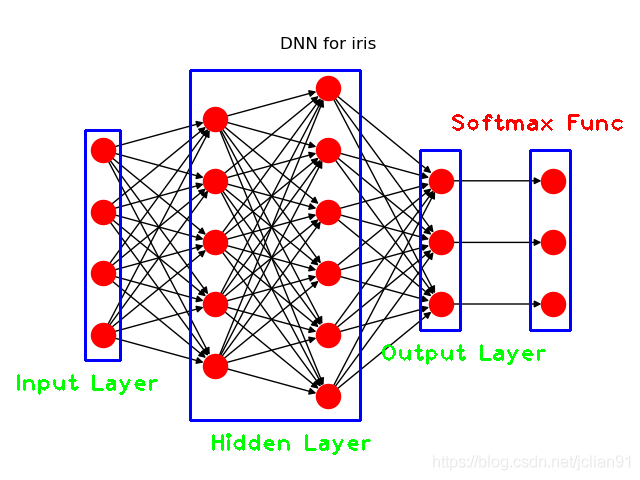本文将会介绍如何利用Keras来实现模型的保存、读取以及加载。
本文使用的模型为解决IRIS数据集的多分类问题而设计的深度神经网络(DNN)模型,模型的结构示意图如下:
具体的模型参数可以参考文章:Keras入门(一)搭建DNN解决多分类问题 。
模型保存
Keras使用HDF5文件系统来保存模型。模型保存的方法很容易,只需要使用save()方法即可。
以Keras入门(一)搭建深度神经网络(DNN)解决多分类问题 中的DNN模型为例,整个模型的变量为model,我们设置模型共训练10次,在原先的代码中加入Python代码即可保存模型:
1 2 3 4 print ("Saving model to disk \n" )"E://logs/iris_model.h5"
保存的模型文件(iris_model.h5)如下:
模型读取
保存后的iris_model.h5以HDF5文件系统的形式储存,在我们使用Python读取h5文件里面的数据之前,我们先用HDF5的可视化工具HDFView来查看里面的数据:
我们感兴趣的是这个模型中的各个神经层之间的连接权重及偏重,也就是上图中的红色部分,model_weights里面包含了各个神经层之间的连接权重及偏重,分别位于dense_1,dense_2,dense_3中。蓝色部分为dense_3/dense_3/kernel:0的数据,即最后输出层的连接权重矩阵。
有了对模型参数的直观认识,我们要做的下一步工作就是读取各个神经层之间的连接权重及偏重。我们使用Python的h5py这个模块来这个iris_model.h5这个文件。关于h5py的快速入门指南,可以参考文章:h5py快速入门指南 。
使用以下Python代码可以读取各个神经层之间的连接权重及偏重数据:
1 2 3 4 5 6 7 8 9 10 11 12 13 14 15 16 17 18 19 20 21 22 23 24 25 26 import h5py'E://logs/iris_model.h5' print ("读取模型中..." )with h5py.File(MODEL_PATH, 'r' ) as f:'/model_weights/dense_1/dense_1' ]'bias:0' ][:]'kernel:0' ][:]'/model_weights/dense_2/dense_2' ]'bias:0' ][:]'kernel:0' ][:]'/model_weights/dense_3/dense_3' ]'bias:0' ][:]'kernel:0' ][:]print ("第一层的连接权重矩阵:\n%s\n" %dense_1_kernel)print ("第一层的连接偏重矩阵:\n%s\n" %dense_1_bias)print ("第二层的连接权重矩阵:\n%s\n" %dense_2_kernel)print ("第二层的连接偏重矩阵:\n%s\n" %dense_2_bias)print ("第三层的连接权重矩阵:\n%s\n" %dense_3_kernel)print ("第三层的连接偏重矩阵:\n%s\n" %dense_3_bias)
输出的结果如下:
1 2 3 4 5 6 7 8 9 10 11 12 13 14 15 16 17 18 19 20 21 22 23 24 25 26 27 28 29 30 读取模型中...0.04141677 0.03080632 -0.02768146 0.14334357 0.06242227 ]0.41209617 -0.77948487 0.5648218 -0.699587 -0.19246106 ]0.6856315 0.28241938 -0.91930366 -0.07989818 0.47165248 ]0.8655262 0.72175753 0.36529952 -0.53172135 0.26573092 ]]0.16441862 -0.02462054 -0.14060321 0 . -0.14293939 ]0.39296603 0.01864707 0.12538083 0.07935872 0.27940807 -0.4565802 ]0.34312084 0.6446907 -0.92546445 -0.00538039 0.95466876 -0.32819661 ]0.7593299 -0.07227057 0.20751365 0.40547106 0.35726753 0.8884158 ]0.48096 0.11294878 -0.29462305 -0.410536 -0.23620337 -0.72703975 ]0.7666149 -0.41720924 0.29576775 -0.6328017 0.43118536 0.6589351 ]]0.1899569 0 . -0.09710662 -0.12964155 -0.26443157 0.6050924 ]0.44450542 0.09977101 0.12196152 ]0.14334357 0.18546402 -0.23861367 ]0.7284191 0.7859063 -0.878823 ]0.0876545 0.51531947 0.09671918 ]0.7964963 -0.16435687 0.49531657 ]0.8645698 0.4439873 0.24599855 ]]0.39192322 -0.1266532 -0.29631865 ]
值得注意的是,我们得到的这些矩阵的数据类型都是numpy.ndarray。
OK,既然我们已经得到了各个神经层之间的连接权重及偏重的数据,那我们能做什么呢?当然是去做一些有趣的事啦,那就是用我们自己的方法来实现新数据的预测向量(softmax函数作用后的向量)。so,
really?
新的输入向量为[6.1, 3.1, 5.1,
1.1],使用以下Python代码即可输出新数据的预测向量:
1 2 3 4 5 6 7 8 9 10 11 12 13 14 15 16 17 18 19 20 21 22 23 24 25 26 27 28 29 30 31 32 33 34 35 36 37 38 39 40 41 42 43 44 45 46 47 48 49 50 51 52 53 54 import h5pyimport numpy as np'E://logs/iris_model.h5' print ("读取模型中..." )with h5py.File(MODEL_PATH, 'r' ) as f:'/model_weights/dense_1/dense_1' ]'bias:0' ][:]'kernel:0' ][:]'/model_weights/dense_2/dense_2' ]'bias:0' ][:]'kernel:0' ][:]'/model_weights/dense_3/dense_3' ]'bias:0' ][:]'kernel:0' ][:]def layer_output (input , kernel, biasreturn np.dot(input , kernel) + biaslambda x: x if x >=0 else 0 )def softmax_func (arr ):sum (exp_arr)return softmax_arr6.1 , 3.1 , 5.1 , 1.1 ]], dtype=np.float32)print ("模型计算中..." )4 )print ("最终的预测值向量为: %s" %output_3)
其输出的结果如下:
1 2 3 读取模型中...[[0.0242 0.6763 0.2995]]
额,这个输出的预测值向量会是我们的DNN模型的预测值向量吗?这时候,我们就需要回过头来看看Keras入门(一)搭建深度神经网络(DNN)解决多分类问题 中的代码了,注意,为了保证数值的可比较性,笔者已经将DNN模型的训练次数改为10次了。让我们来看看原来代码的输出结果吧:
1 2 3 4 5 6 7 8 Using model to predict species for features: [[6.1 3.1 5.1 1.1]] [[0.0242 0.6763 0.2995]]
Yes,两者的预测值向量完全一致!因此,我们用自己的方法也实现了这个DNN模型的预测功能,棒!
模型加载
当然,在实际的使用中,我们不需要再用自己的方法来实现模型的预测功能,只需使用Keras给我们提供好的模型导入功能(keras.models.load_model())即可。使用以下Python代码即可加载模型
1 2 3 4 5 6 7 8 9 10 11 12 13 14 from keras.models import load_modelprint ("Using loaded model to predict..." )"E://logs/iris_model.h5" )4 )6.1 , 3.1 , 5.1 , 1.1 ]], dtype=np.float32)print ("Using model to predict species for features: " )print (unknown)print ("\nPredicted softmax vector is: " )print (predicted)for k, v in Class_dict.items()}print ("\nPredicted species is: " )print (species_dict[np.argmax(predicted)])
输出结果如下:
1 2 3 4 5 6 7 8 9 Using loaded model to predict...for features: 6.1 3.1 5.1 1.1 ]]is : 0.0242 0.6763 0.2995 ]]is :
总结
本文主要介绍如何利用Keras来实现模型的保存、读取以及加载。
本文将不再给出完整的Python代码,如需完整的代码,请参考Github地址:https://github.com/percent4/Keras_4_multiclass.
欢迎关注我的公众号
NLP奇幻之旅 ,原创技术文章第一时间推送。
欢迎关注我的知识星球“自然语言处理奇幻之旅 ”,笔者正在努力构建自己的技术社区。




